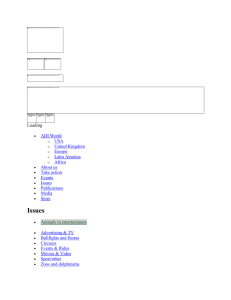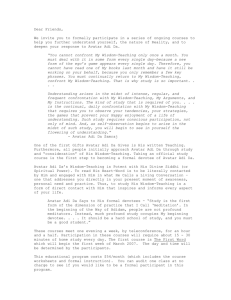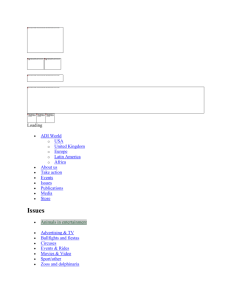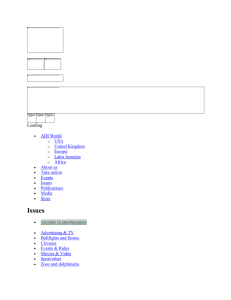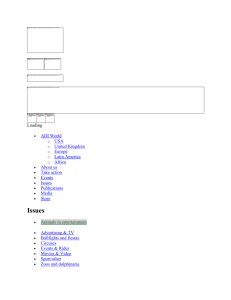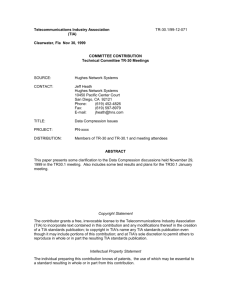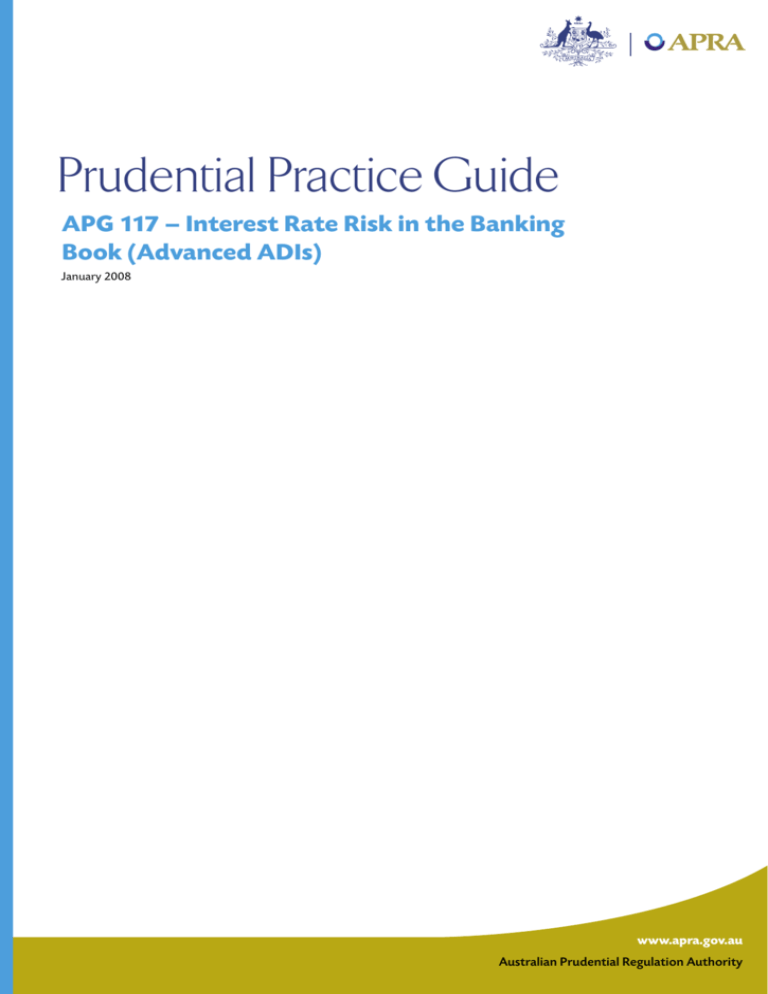
Prudential Practice Guide
APG 117 – Interest Rate Risk in the Banking
Book (Advanced ADIs)
January 2008
www.apra.gov.au
Australian Prudential Regulation Authority
Disclaimer and copyright
This prudential practice guide is not legal advice and
users are encouraged to obtain professional advice
about the application of any legislation or prudential
standard relevant to their particular circumstances and
to exercise their own skill and care in relation to any
material contained in this guide.
APRA disclaims any liability for any loss or damage
arising out of any use of this prudential practice guide.
This prudential practice guide is copyright. You may
use and reproduce this material in an unaltered form
only for your personal non-commercial use or noncommercial use within your organisation. Apart from
any use permitted under the Copyright Act 1968, all
other rights are reserved. Requests for other types of
use should be directed to APRA.
Australian Prudential Regulation Authority
2
About this guide
Prudential Standard APS 117 Capital Adequacy: Interest
Rate Risk in the Banking Book (APS 117) sets out
APRA’s requirements of authorised deposit-taking
institutions (ADIs) in relation to the management and
measurement of interest rate risk in the banking book
(IRRBB) and the holding of regulatory capital against
this risk. This prudential practice guide aims to assist
ADIs in complying with these requirements and, more
generally, to outline prudent practices in relation to
the management and measurement of IRRBB.
Subject to the requirements of APS 117, ADIs have
the flexibility to configure their IRRBB management
framework in the way most suited to achieving their
business objectives.
Australian Prudential Regulation Authority
3
Contents
Repricing and yield curve risks
5
Repricing assumptions
5
Non-interest income
5
Approaches to modelling interest rate variability
5
Earnings offset
6
Basis risk
Numerical example of basis risk
Optionality risk
7
8
9
Fixed-interest capital instruments
10
Interest rate risk in the banking book management framework
10
Australian Prudential Regulation Authority
4
Repricing and yield curve risks
(e) interest rate swaps could be treated as two
notional positions with relevant tenors (e.g.
a fixed-for-floating interest rate swap under
which the ADI is paying fixed-rate interest
may be treated as a principal outflow at the
maturity date of the swap and a principal
inflow at the next interest rate reset date); and
Repricing assumptions
1.
To estimate repricing and yield curve risks,
APS 117 requires an ADI to make repricing
assumptions regarding the repricing of items that
do not have a contractually defined repricing date
or where there is potential for significant variation
between contractual and actual repricing dates.
An ADI’s repricing assumptions typically include
the following:
(a) fixed-rate banking book items could be
assumed to reprice according to the residual
term to expected principal repayments, while
floating-rate items could be assumed to
reprice according to the residual term to the
next expected repricing date. For the purpose
of determining the expected amount and
timing of principal payments, the ADI would
normally take into account expected customer
behaviour, such as prepayments;
(b) banking book items that are large in volume
and small in individual amount, such as
instalment or mortgage loans, may be given
a simplified assumed repricing term based on
statistically supported assessment methods;
(f) options could be treated on the basis of the
delta-equivalent amounts of the underlying or
the notional underlying. A more sophisticated
approach would involve full revaluation at the
beginning and end of the holding period.
2.
Non-interest income
3.
(c) banking book items with no or low associated
interest flows, such as at-call non-interest
bearing deposits and low-interest transaction
accounts, may be assumed to have a repricing
term that is either zero or a longer period that
reflects the lack of sensitivity of the customer
rate (if any) to wholesale market rates. An
ADI would generally be expected to provide
analysis to support use of a non-zero term;
(d) futures and forward contracts, including
forward rate agreements, may be treated as a
combination of long and short positions (e.g.
an ADI that has bought a June 90-day bank bill
future could report the position, as at April,
as a principal outflow at two months and a
principal inflow at five months);
Australian Prudential Regulation Authority
An ADI’s repricing assumptions broadly portray
the expected repricing of its banking book items.
Prepayments or interest rate renegotiations for
which the ADI charges an economic penalty that
approximates the economic cost of altering from
the contractual position, could provide a basis for
using contractual rather than expected repricing.
In modelling repricing and yield curve risks, an
ADI’s internal model would generally reflect
all material interest rate sensitivities associated
with the ADI’s banking book items, including
sensitivities arising from both interest income and
non-interest income. Examples of items where
interest rate sensitivity arises from non-interest
income include:
(a) servicing rights and other fee income streams
from products (not necessarily issued or
owned by the ADI), the volumes of which are
correlated with interest rates; and
(b) properties owned by the ADI that have values
that are materially affected by interest rates.
Approaches to modelling interest rate
variability
4.
APRA believes it is unnecessarily prescriptive to
specify the model used by an ADI to measure its
risk. However, paragraph 29 of APS 117 requires an
ADI to ensure that its modelling approach meets
the soundness standard, so some guidance is
appropriate on this point.
5
5.
1
The most common approach used by ADIs in
(e) using antithetic variables (e.g. for each yield
Australia for modelling changes in market rates
curve change in the observation set, also
in recent years has been the historical sampling
using the opposite change, on an arithmetic
approach. A difficulty encountered under this
or geometric basis as is determined to be
approach with a one-year holding period is the
appropriate) or other variance reduction
absence of a data set of independent observations
techniques, where determined to be
large enough to use for estimating a 99 per cent
appropriate, to maximise the amount of
confidence interval. A larger set of observations
information than can be extracted from the
from which to draw can be obtained by using
limited data set.
changes over overlapping one-year intervals
6. If an ADI uses a chain-linked Monte Carlo
at daily rests, over a period of six years or so.
approach, consideration could be given to the
However, this approach introduces a problem
appropriateness of setting the simulated changes
that the overlap will cause very heavy correlation
within a ‘term structure model’ framework that
between the observations, thereby undermining
imposes certain relationships between rates of
the statistical validity of the method. It will be
different tenor and constrains how rates at a given
more difficult for an ADI to satisfy APRA that
tenor may change over time. Such approaches
an approach using overlapping periods satisfies
may contain elements such as mean reversion
the soundness standard than an approach that
and use of implied volatilities observed from
does not suffer from the problem of correlated
market instruments. These approaches typically
observations. Some other approaches that could
have more degrees of freedom than historical
be taken which do not suffer from this problem, or
sampling, providing more flexibility to the user.
which can mitigate it, are:
Although such flexibility can be positive, allowing
(a) modelling interest rate changes over a
the user to better tailor the model to reflect the
shorter holding period using non-overlapping
risks, APRA envisages that any approach chosen
observations (by a method of the ADI’s choice,
will be used consistently.
e.g. historical sampling, variance-covariance,
Monte Carlo) and scaling up the changes by a Earnings offset
suitable factor before applying to the portfolio
7. When modelling the amount of regulatory
to get a simulated profit and loss result;
capital required by an ADI for repricing and yield
(b) measuring value-at-risk (VaR) over a shorter
curve risks, APS 117 allows the ADI to include an
holding period using non-overlapping
earnings offset which is an adjustment for the
observations (again by a method of the ADI’s
impact of interest rate changes on economic
choice) and scaling up the result by a suitable
value-based earnings during the holding period.
factor;
In essence, the adjustment will tend to offset
changes in the economic value of the ADI’s
(c) using Monte Carlo simulation to generate
banking book.1
interest rate changes over successive short
periods and chain-linking the changes
8. As detailed in APS 117, the earnings offset is
over these shorter periods to build up the
the economic value, as at the beginning of the
simulated changes over a year;
holding period (time t), of a notional portfolio of
fixed-for-floating interest rate swaps. In calculating
(d) in combination with using a shorter holding
the earnings offset of the notional portfolio,
period and scaling up to one year, measuring
APRA would generally envisage the following
results for a lower confidence level than
assumptions to be applied:
99 per cent and scaling up to 99 per cent
using a ratio of percentiles from a suitable
(a) the ADI receives fixed-rate payments;
reference distribution; and
For example, an interest rate increase will generally reduce the economic value of the banking book, but economic value-based earnings will be higher
for the period from the increase date to the end of the holding period.
Australian Prudential Regulation Authority
6
(b) the maturity dates of the interest rate swaps
are at monthly intervals from one to
12 months after time t;
(c) the inception dates for the swaps maturing m
months after time t are at monthly intervals
from time t back to (12 - m) months before
time t (i.e. there are 78 swaps in the notional
portfolio);
(d) the fixed rate for each interest rate swap is the
rate that would have applied at its inception
given its original maturity; and
(e) the principal amount of each swap incepted
at k months before time t and maturing m
months after t is 1/12 times;
(i) if k + m=12 (i.e. the swap has an original
maturity of 12 months), the book value of
the banking book at the swap’s inception
date, or
(ii) the increase in the book value of the
banking book over the month immediately
preceding the swap’s inception date.
Variations from the above assumptions by an ADI
may be considered by APRA on a case-by-case basis.
9.
The moving average of the notional portfolio of
interest rate swaps extends out to 12 months in
order to match the length of the holding period
required by the soundness standard detailed
in APS 117. The impact of the earnings offset
on the ADI’s IRRBB capital requirement will
be approximate to the economic-value-based
earnings offset that arises during the 12-month
holding period from interest rate changes,
assuming that the ADI maintains a stable repricing
profile for its banking book throughout that
period. The effect of including the earnings
offset is mechanically equivalent to assuming
an investment term of capital of 12 months;
however, the reasoning for the earnings offset’s
inclusion may not be the same as ADIs use when
deciding their investment term of capital for
internal management of interest rate risk.
Australian Prudential Regulation Authority
Basis risk
10. APS 117 includes basis risk as one of the four
components of IRRBB. Basis risk is the risk of loss
in earnings or economic value of the banking book
arising from imperfect correlation in the adjustment
of the interest rates earned and paid on different
instruments with otherwise similar repricing
characteristics. For the purpose of APS 117, this may
comprise losses or gains arising from differences
between the actual and expected interest margins
earned by products over their implied cost of funds,
over a specified holding period.
11. Basis risk typically includes the following
exposures:
(a) where a product interest rate moves in the
same way as the implied cost of funds, but
with a lead or lag. This may occur, for example,
where an ADI’s repricing assumptions specify
that variable rate loans reprice overnight but,
in practice, interest rate changes tend to lag
by several days changes in the Reserve Bank of
Australia’s cash rate target;
(b) for certain transaction accounts, the product
interest rate may generally move in line with
the implied cost of funds, except where the
implied cost of funds falls below a low barrier.
At that point, the zero floor on the customer
rate forces interest margins to compress and
the correlation between the product interest
rate and the implied cost of funds breaks down;
(c) non-interest bearing accounts where there
is no portfolio of wholesale instruments
that can replicate the lack of variation in the
product rate. There will always, therefore, be
deviations between the movement of the
accounts’ interest rate and that of the implied
cost of funds;
(d) products where there is no portfolio that
can accurately model the movement of
the product customer interest rate in all
circumstances. This may include items such as
deeming accounts and mortgages that have
capped, but not fixed, rates;
7
(e) where repricing assumptions for a product
are poorly chosen, large differences may arise
between the movement of the product rate
and that of the implied cost of funds and
generate material basis risk gains and losses;
(f) in the case where repricing assumptions
provide a good fit for the product interest
rate, there will usually be an error term
representing unavoidable, random, residual
deviations between the movement of the
product rate and that of the implied cost of
funds; and
Numerical example of basis risk
13. Consider the case of a transaction account that
pays different rates of interest (set at the ADI’s
discretion) on different tiered balances, with most
tiers paying interest several percentage points
below wholesale rates. The repricing assumption
for this portfolio might be that it reprices in 12
equal tranches at intervals from one to 12 months
into the future. These assumptions may have been
chosen as a reasonable, simplified approximation
of the way the product’s average interest rate2 has
been observed to change over time.
(g) where the interest rate on a banking book
item is based on a different yield curve from
the one used to analyse repricing and yield
curve risks. A Commonwealth Government
bond held in the banking book, for example,
will price off the government yield curve,
which is similar, but not identical, to the swap
curve used by many ADIs to assess IRRBB.
The ADI may have expectations of interest rates
for the next 12 months as shown in Table 1 below.
The implied cost of funds is based on a rolling
average of 12-month rates, consistent with the
ADI’s repricing assumption.
Actual interest rates may move over the
12-month period as shown in Table 2. The
bottom two rows show the difference between
actual and expected margins, which is a loss over
the 12-month period of 0.45 per cent of the
average of the monthly total balances. This is the
product loss from basis risk over the period.
12. For the purpose of APS 117, basis risk would
typically not include variations in repricing
caused by customers behaving differently from
what is assumed in the repricing assumptions as
such variations would generally be classified as
optionality risk.
Table 1: Expected interest rates (for the 12 months to June)
2
Expected
interest rates
(% p.a.)
July
Aug
Sep
Oct
Nov
Dec
Jan
Feb
Mar
Apr
May
Jun
Implied cost
of funds
5.14
5.18
5.24
5.29
5.36
5.42
5.49
5.57
5.64
5.70
5.76
5.82
Product rate
1.50
1.52
1.55
1.58
1.60
1.62
1.64
1.65
1.66
1.68
1.69
1.71
Margin
3.64
3.66
3.69
3.71
3.76
3.80
3.85
3.92
3.98
4.02
4.07
4.11
Average interest rate for a period is total interest paid over the period, divided by average balance, across all accounts.
Australian Prudential Regulation Authority
8
Table 2: Actual interest rates (for the 12 months to June)
Actual interest
rates (% p.a.)
July
Aug
Sep
Oct
Nov
Dec
Jan
Feb
Mar
Apr
May
Jun
Implied cost
of funds
5.14
5.09
5.04
4.99
4.94
4.89
4.84
4.79
4.74
4.69
4.64
4.59
Product rate
1.50
1.51
1.52
1.51
1.50
1.48
1.46
1.44
1.42
1.41
1.40
1.40
Margin
3.64
3.58
3.52
3.48
3.44
3.41
3.38
3.35
3.32
3.28
3.24
3.19
Margin
shortfall3
0.00
0.08
0.17
0.23
0.32
0.39
0.47
0.57
0.66
0.74
0.83
0.92
Cumulative
shortfall
0.00
0.01
0.02
0.04
0.07
0.10
0.14
0.19
0.24
0.30
0.37
0.45
Optionality risk
14. APS 117 includes optionality risk as one of the
four components of IRRBB. Optionality risk in
the banking book is the risk of losses arising due
to the existence of stand-alone or embedded
options4 in banking book items, to the extent
that the potential for those losses is excluded
from the measurement of repricing, yield curve
or basis risks. In the case of options embedded
in customer products, it will generally arise from
customers exercising choices that cause the actual
product repricing dates to deviate from those
specified in the ADI’s repricing assumptions.
15. Optionality risk typically includes the following
exposures:
(a) where an ADI’s customers make greater
(lower) than expected levels of fixed-rate
loan prepayments after an interest rate
decline (rise), and the full economic cost of
prepayment is not charged to the customer;
(b) where customers make greater-than-expected
net withdrawals from nil or low-interest, at-call
deposit accounts following an interest rate
rise, and funds from those accounts have been
invested at term by the ADI;
(c) where customers decline to drawdown on
rate-lock facilities5 where the interest rate has
reduced since taking out the facility; and
(d) interest rate options and other derivatives or
securities with option characteristics.
16. The lack of a causal relationship between
interest rate changes and customers’ exercise of
embedded options does not necessarily mean
that there is no optionality risk. Balances in a
particular non-interest bearing account may, for
example, vary between quarters in a way that
is unrelated to interest rates and therefore no
correlation would be observed. Nevertheless, if
that random balance variation gives an unusually
sharp drop in the balance of the portfolio in a
quarter that follows a quarter with a large rise in
interest rates, the ADI will generally incur losses
as it has to sell term assets at reduced prices to
pay customers’ withdrawals (assuming account
balances were not invested overnight).
3
This is the difference between the expected margin and the actual margin.
4
An option provides the holder the right, but not the obligation, to buy, sell, or in some manner alter the cash flow of an instrument or financial contract.
5
A rate-lock facility provides a borrower, at the time of loan approval, the option of drawing down on a loan at a guaranteed interest rate. The option will
typically have a defined period of, for example, 90 days.
Australian Prudential Regulation Authority
9
Fixed-interest capital instruments
17. Under APS 117, an ADI’s IRRBB capital
requirement is calculated as the interest
rate sensitivity of the economic value of its
Fundamental Tier 1 capital. Under this approach,
the interest rate sensitivity of hedges over fixedinterest capital instruments are considered to
be offset by the interest rate sensitivity of the
instruments they hedge, as those instruments are
outside of APRA’s definition of Fundamental Tier
1 capital. However, in a liquidation scenario, this
offset may disappear to the extent that the capital
instrument absorbs the losses. At the time of
liquidation there is a risk of loss if the hedge was
out of the money and this was not included in the
ADI’s estimate of its IRRBB capital requirement.
This risk increases as the volume and/or term
of the ADI’s fixed-interest capital instruments
gets larger and/or longer. As a guide, an ADI
is expected to consider this risk in assessing its
overall IRRBB exposure.
Interest rate risk in the banking
book management framework
18. APS 117 states that an ADI’s IRRBB measurement
system must be closely integrated into the ADI’s
risk management processes. APRA is aware
that most ADIs, in their own calculations for
economic capital and risk limit comparisons,
use different holding periods and confidence
levels for the measurement of repricing and yield
curve risk from that prescribed in APS 117 for
the purpose of determining the IRRBB capital
requirement. APRA does not generally consider
such differences to be a failure to integrate the
risk measurement system, as long as the same
system is used for both purposes, with only the
parameters differing.
Australian Prudential Regulation Authority
19. APS 117 states that an ADI’s IRRBB measurement
system must monitor the ADI’s risk profile in
terms of earnings at risk and economic value
sensitivity. As good practice, APRA envisages that
this process would occur on at least a monthly
basis and that the results of this process would
also be reviewed on a monthly basis by the senior
management committee detailed in Attachment
A to APS 117.
20. Attachment A to APS 117 states that an ADI’s Board
of directors, or committee thereof, must review
on a regular basis IRRBB management reports and
satisfy itself that this risk is being appropriately
managed. As good practice, APRA envisages that
such reviews would occur on at least a quarterly
basis.
21. Attachment A to APS 117 requires periodic
independent reviews of an ADI’s framework
for managing IRRBB. As a guide, such a review
would typically involve an assessment of
whether the IRRBB management framework
and measurement system is being implemented
effectively across the ADI, and the review would
include an assessment of:
(a) the accuracy and adequacy of the ADI’s
policies and supporting documentation
for managing and measuring IRRBB as
well as the ADI’s compliance with, and
consistent application of, those policies and
documentation;
(b) compliance with the requirements of APS 117;
(c) the structure and resources of the risk
management unit;
(d) the scope of IRRBB captured by the
measurement system and an assessment
of whether the system captures all material
IRRBB exposures from all relevant geographic
locations;
10
(e) the consistency, timeliness, reliability and
completeness of data that are incorporated
into the model, including the independence of
such data sources;
(f) the robustness and mathematical correctness
of the model and the reasonableness of
assumptions made in the model or elsewhere
in the measurement system, such as interest
rate volatility and correlation assumptions,
distributional assumptions, cross-currency
assumptions and assumptions about customer
behaviour, including repricing assumptions;
(g) the integrity of the management information
system, including the appropriateness and
accuracy of the management reports related
to the output of the model;
(h) the adequacy of the ADI’s model performance
testing;
(i) the robustness and adequacy of the ADI’s
stress testing program;
(j) the appropriateness of model validation
processes, including the adequacy of
procedures and controls over changes in
model inputs, assumptions and calculation
methodologies and assessment of the
operation of those processes and validation
of any significant change in the measurement
system; and
(k) the integration of the measurement system
into daily IRRBB management processes.
Australian Prudential Regulation Authority
11
Telephone
1300 13 10 60
Email
contactapra@apra.gov.au
Website
www.apra.gov.au
Mail
GPO Box 9836
in all capital cities
(except Hobart and Darwin)

